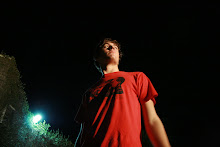"Isn't this where..."
Here is a quick overview of the cycle:
World of Light, Life, Consciousness (The world as we know it)
1. Start- The hero starts in the world of light and wants change. Often this is manifested in a desire to leave home.
2. Herald- A herald comes and issues a call to adventure which the hero must accept.
3. Guide- An individual, who has undergone a journey of their own before, and must have credentials that impress the hero, accompanies the hero upon their way.
4. First Threshold Battle- The hero, accompanied by the guide, encounters his father figure in the form of a monster. The monster is a keeper of the status quo and strives to keep the hero from maturing.
If the hero succeeds, he dies to the world of light and is reborn into the:
World of Dark, Death, and Unconsciousness (The underworld)
5. Adventures and temptations- Multiple obstacles try to distract the hero from continuing on his journey, but the hero must ignore them in order to continue on and succeed.
6. Goddess- A character of the opposite gender to the hero is revealed as the hero's anima, or the feminine side of man. (A female hero encounters her animus, or the masculine side of woman). The hero is completed by coming in touch with their opposite side (like a yin-yang).
7. Separation of hero and guide- So the hero can mature by themselves, separation from the guide is pertinent.
8. Apotheosis- The hero makes a sacrifice, and is in turn elevated to god-like status.
9. Atonemenet- Literally meaning "at one with". The hero and his father figure become equals.
10. Final Threshold Battle- The hero again encounters his father figure face to face and defeats him to enter back into the world of light.
World of Light, etc.
11. Treasure- A non-material treasure is bestowed onto the world by the hero.
12. Guide for others- Having completed his own cycle, the hero becomes a guide for others on their journeys.
George Lucas had the idea of Star Wars in mind for a while before he knew how to write the story. When he encountered Campbell's book, he had the format in his hands and drew up the story accordingly. Luke Skywalker, the hero, accompanied by his guide Obi-Wan Kenobi, eventually defeats his literal father Darth Vader (which in Dutch translates literally to "Dark Father". The English teacher who introduced me to Joseph Campbell also made the bold statement, which I agree with, that a book is only literature if it relates to the human condition. He also said that any movie that concerned the role and existence of man on earth was a piece of literature in itself.
Ultimately, my teacher told me that the cosmogonic cycle applies not only to myths and literature, but also to our own lives. Because myths are about the adventures of humans, and we are human, the cosmogonic cycle can be used to trace our own journey. It took me a while to realize this, but when I did, it gave a whole new meaning to literature, life, and myself. Each of us is a hero by ourselves, and we undergo our own journeys as we go through life. The wonderful thing about the cosmogonic cycle is that, while you are in one world, the events don't have to happen in any particular order. For example, I may have already met my goddess and I am just beginning to be subject to trials and tribulations through the IB.
Some have criticized the cosmogonic cycle, claiming that it "systemizes" literature. However, it simply shows the correlations that literature has to the human condition. It makes us realize why we read stories and myths, and that is to discover something about the philosophical nature of ourselves and our existence. All literary novels, movies, and albums are different or unique in some way, but they are all similar in that they tell the story of a hero and his journey for completion on this earth. Throughout life, we all strive for completion, and the cosmogonic cycle has just helped to show the stages we may go through.
Though I am much unlike him, I analyzed the anti-hero Pink from Pink Floyd's The Wall using the cosmogonic cycle. As an anti-hero, Pink separates himself from society by building a wall and entering into the underworld. However, in "The Trial", the wall is broken down and he is fortunate enough to enter back into the world of light. Though an anti-hero, his story still follows the cosmognic cycle, as he eventually overcomes his controlling mother by the end of the concept album. I am not certain whether or not Roger Waters read Campbell's novels or knew about the archetypal hero, but the band made clear that the album was cyclical in nature. At the end of the album, amongst the horns, you hear the words "Isn't this where..." (the title of this post) being uttered. On old LPs, the record would turn over and go directly to the first track again, which starts with the same music that the album "ended" with. Right at the beginning, you hear the words that complete the question and make the album cyclical:
"...where we came in?"

No comments:
Post a Comment